PIETRO FIORENTINI Aperflux 101 Owner's manual
- Type
- Owner's manual

A
perflux
MT-208-E
ENGLISH
PRESSURE
REGULATOR
TECHNICAL MANUAL
INSTALLATION, COMMISSIONING
AND MAINTENANCE INSTRUCTIONS

Technical manual MT 208-E 1
INLET PRESSURE OUTLET PRESSURE CONTROL PRESSURE
Pressure Regulator

Technical manual MT 208-E 2
PRECAUTION
GENERAL PRECAUTION
The apparatus described in this manual is a device subject to pressure
installed in systems under pressure.
The apparatus in question is normally installed in systems for
transporting flammable gases (natural gas, for example).
PRECAUTION FOR THE OPERATORS
Before proceeding with installation, commissioning or maintenance,
operators must:
Examine the safety provisions applicable to the installation in
which they must work;
Obtain the authorisations necessary for working when
required;
Use the necessary means of individual protection (helmet,
goggles, etc.);
Ensure that the area in which they operate is fitted with the
means of collective protection envisaged and with the
necessary safety indications.
HANDLING
The handling of the apparatus and of its components must only be
carried out after ensuring that the lifting gear is adequate for the loads
to lift (lifting capacity and functionality). The apparatus must be
handled using the lifting points provided on the apparatus itself.
Motorised means must only be used by the persons in charge of them.
PACKING
The packing for transportation of equipment and of relevant spare parts
are designed and shaped to avoid damage to any part during
transportation, warehousing and handling activities. Therefore the
equipment and spare parts shall be kept into their packing until their
installation in the final site. After packing is open, check that no
damage occurred to any goods. If damage occurred inform the supplier
and keep packing for any verification.
INSTALLATION
The installation of the pressure regulator has to occur in compliance
with the provisions (laws or standards) in force in the place of
installation.
Natural gas plants have to show features in compliance with the law
provisions and standard requirements in force in the place of
installation or at lease in compliance with standards EN 12186 or EN
12279. In detail, it is necessary to meet the provisions of paragraphs
6.2, 7.5.2, 7.7, 9.3 of the standard EN 12186 and 6.2, 7.4, 7.6, 9.3 of
the EN 12279 standard. The installation in compliance with such
standards minimizes the risk of fire hazard and the formation of
potentially explosive atmospheres.
The valve is not equipped with external pressure limitation devices;
therefore, it has to be installed making sure that the operating pressure
of the assembly on which it is installed does not exceed the maximum
allowable pressure (PS).
Therefore, the user, as deemed necessary by the same, shall install on
the assembly suitable pressure limitation systems, as well as provide
the plant with suitable relief or drain systems in order to discharge the
pressure and fluid contained in the plant before proceeding with any
inspection and maintenance activity.
If the installation of the apparatus requires the application of
compression fittings in the field, these must be installed following the
instructions of the manufacturer of the fittings themselves. The
choice of the fitting must be compatible with the use specified for the
apparatus and with the specifications of the system when envisaged.
COMMISSIONING
Commissioning must be carried out by adequately trained personnel.
During the commissioning activities, the personnel not strictly
necessary must be ordered away and the no-go area must be properly
signalled (signs, barriers, etc.).
Check that the settings of the apparatus are those requested; if
necessary, reset them to the required values in accordance with the
procedures indicated in the manual.
When commissioning, the risks associated with any discharges into the
atmosphere of flammable or noxious gases must be assessed.
In installations in natural gas distribution networks, the risk of the
formation of explosive mixtures (gas/air) inside the piping must be
considered.

Technical manual MT 208-E 3
1.0 INTRODUCTION 4
1.1 MAIN FEATURES 4
1.2 OPERATION OF THE PRESSURE REGULATOR WITH
THE SERIES 300 PILOT 4
1.3 PILOTS 5
1.4 REGULATING VALVE 6
1.5 SETTING SPRINGS 6
2.0 INSTALLATION 7
2.1 GENERAL 7
2.2 CONNECTING THE APPARATUSES 8
2.3 DOWNSTREAM VOLUME REQUIRED FOR INSTALLATION 9
3.0 IN LINE ACCESSORIES 9
3.1 RELIEF VALVE 9
3.1.1 DIRECT INSTALLATION IN THE LINE 9
3.1.2 INSTALLATION WITH ON/OFF VALVE 10
3.2 ACCELERATOR 10
3.3 SB/82 SLAM SHUT VALVE 10
4.0 IN LINE MONITOR 11
5.0 START-UP 11
5.1 GENERAL 11
5.2 GAS INPUT, CONTROLL OF EXTERNAL TIGHTNESS
AND SETTING 12
5.3 COMMISSIONING THE REGULATOR 12
5.4 COMMISSIONING THE REGULATOR APERFLUX 101
PLUS APERFLUX 101 IN-LINE MONITOR 12
5.5 COMMISSIONING THE REGULATOR APERFLUX 101
PLUS REFLUX 819 IN-LINE MONITOR WITH INCORP. SB 82 13
6.0 TROUBLE-SHOOTING 15
6.1 TABLE 14 APERFLUX 101 REGULATOR 15
7.0 MAINTENANCE 16
7.1 GENERAL 16
7.2 APERFLUX 101 REGULATOR MAINTENANCE
PROCEDURE 16
7.3 DISASSEMBLING THE REGULATOR UNIT 16
7.4 DISASSEMBLING UNIT 302/A PILOT 18
7.4.1 PILOT 302/A 18
7.5 DISASSEMBLING UNIT 304/A PILOT 22
7.5.1 PILOT 304/A 22
7.6 DISASSEMBLING AR/100 FLOW REGULATING VALVE 25
8.0 FINAL OPERATION 35
8.1 CHECKING THE TIGHTNESS AND SETTING 35
8.2 START UP 35
- INDEX -

Technical manual MT 208-E 4
1.0 INTRODUCTION
The scope of this manual is to provide the essential information for
the installation, commissioning, disassembly, re-assembly and
maintenance of APERFLUX 101 regulators.
It is also appropriate to provide a brief illustration of the main features
of the regulator and of its accessories.
1.1 MAIN FEATURES
The APERFLUX 101 pressure regulator is a regulator for medium and
high pressure.
The APERFLUX 101 is a “fail open” type regulator and therefore opens
in the event of:
- rupture of the main diaphragm
- no feed in the pilot circuit
The main specifications of this regulator are:
- Design pressure: up to 85 bar (1232,8 Psi)
- Working temperature range: -20°C + 60 °C (-4 to + 140 °F)
- Ambient temperature: -20°C + 60 °C (-4 to + 140 °F)
- Inlet pressure range bpu: 1,8 to 85 bar (26,1 to 1232,8 Psi)
- Regulating range possible Wd: 0,8 ÷ 74 bar (11,6 to 1073,3 Psig)
(depending on the pilot installed)
- Minimum differential pressure 1 bar (14,5 Psig). Recommended >2
bar (29 Psig)
- Precision class AC: up to 1 (depending on the operative conditions)
- Closing pressure class SG 10 (depending on the operative
conditions)
1.2 OPERATION OF THE PRESSURE REGU-
LATOR WITH SERIES 300 PILOT (fig.1)
In the absence of pressure, the main diaphragm 20 is maintained in the
closed position by the spring 45 and rests on the seat of the valve with
grill 13. The seal is guaranteed by the contact between the valve
seat 13 and the diaphragm 20. In normal working conditions, the
following forces act on the diaphragm 20:
- downwards: the load of the spring 45, the thrust deriving from the
control pressure Pc in the control chamber A and the weight of the
mobile assembly;
- upwards: the thrusts deriving from the upstream pressure Pu, the
downstream pressure Pd and the remaining dynamic components.
The control pressure Pc is obtained by drawing gas at the pressure
Pu directly upstream from the diaphragm 20. The gas is filtered by
the filter incorporated in the AR100 flow regulating valve. The
pressure Pc is governed by the pilot which regulates its value. The
regulation is obtained from the comparison of the load of the setting
spring 22 and the thrust on the diaphragm 42 deriving from the
downstream pressure. If during operation, for example, there is a
drop in the downstream pressure Pd below the set point (as a result
of an increase in the flow demand or of a reduction of the upstream
pressure), a state of imbalance of the mobile assembly 5 is created
and leads to an increase in the opening of the obturator 17 and
therefore a reduction of the control pressure Pc. As a result, the
diaphragm 20 moves upwards increasing the opening of the
regulator until the downstream pressure reaches the set point again.
On the other hand, when the downstream pressure rises beyond the
set point (as a result of a reduction in the demand or with the increase
in the upstream pressure), the obturator 17 closes and therefore the
pressure Pc reaches the value of the upstream pressure Pu. In these
conditions, the diaphragm 20 goes to the closed position. In normal
working conditions, the obturator 17 is positioned in such a way that
the pressure Pc above the diaphragm 20 is such as to maintain the
downstream pressure around the selected value.
fig. 1

Technical manual MT 208-E 5
1.3 PILOTS
Pressure Regulators APERFLUX 101 use following type of pilots:
302/. setting range Wd: from 0,8 to 9,5 bar; (11,6 to 137,7 psig)
304/. setting range Wd: from 7 to 43 bar; (101,5 to 623,5 psig)
305/. setting range Wd: from 20 to 60 bar; (290 to 870,2 psig)
307/. setting range Wd: from 41 to 74 bar; (594,6 to 1073,3 psig)
Pilots may be adjusted manually or remotely as shown in table 1:
Table 1: Pilot adjusting instructions
Pilot type…/A
Manual setting
Pilot type…/D
Electric remote setting control
Pilot type…CS
Setting increased by pneumatic signal
remote point
Fig.2
Pilot 302/A
Fig.4
Pilot 307/A
fig. 3
Pilot 304/A

Technical manual MT 208-E 6
1.4 AR/100 REGULATING VALVE
Pilots series 300 are equipped with regulation valve AR 100
1.5 Tab 2: SETTING SPRINGS
SPRING CHARACTERISTICS PILOT 302/A
Code Color De Lo d Setting range (bar)
2701800 YELLOW 35 100 4,5 0,8 ÷ 1,4
2702080 ORANGE 35 100 5 1,4 ÷ 2,4
2702290 RED 35 100 5,5 2,4 ÷ 4,2
2702460 WHITE/ORANGE 35 100 6 4,2÷ 6,2
2702660 BLACK 35 100 6,5 6,2 ÷ 9,5
SPRING CHARACTERISTICS PILOT 304/A
Code Color De Lo d Setting range (bar)
2702290 RED 35 100 5,5 7 ÷ 10
2702460 GREEN 35 100 6 10 ÷ 15
2702660 BLACK 35 100 6,5 15 ÷ 22
2702820 BLUE 35 100 7 22 ÷ 33
2703045 BROWN 35 100 7,5 33 ÷ 43
SPRING CHARACTERISTICS PILOT 305/A
Code Color De Lo d Setting range (bar)
2702820 BLUE 35 100 7 20 ÷ 33
2703045 BROWN 35 100 7,5 33 ÷ 42
2703224 GREY 35 100 8 42 ÷ 60
SPRING CHARACTERISTICS PILOT 307/A
Code Color De Lo d Setting range (bar)
2703224 GREY 35 100 8 41 ÷ 74
De = Ø esternal diameter d = Ø Wire diameter Lo = Length
Fig.5

Technical manual MT 208-E 7
2.0 INSTALLATION
2.1 GENERAL
Pressure regulator does not require any supplementary upstream
safety accessory for protection against overpressure compared with its
design pressure PS, when upstream reducing station is sized for a max
downstream incidental pressure
MI Pd ≤ 1,1 PS
Before installing the regulator it is necessary to ensure that:
- the regulator can be inserted in the space provided and that
subsequent maintenance operations will be sufficiently practicable
- the upstream and downstream piping is at the same level and
capable of supporting the weight of the regulator
- the inlet/outlet flanges of the piping are parallel
- the inlet/outlet flanges of the regulator are clean and the regulator
itself has not been subject to damage during transport
- the piping upstream has been cleaned to expel residual impurities
such as welding scale, sand, paint residues, water, etc.
The usually foresee arrangement is one indicated in fig. 6.
Tab. 3: Overall dimensions in mm
Type DN Inches A B C
D
ANSI
300
D
ANSI
600
E F G H
S
ANSI
300
S
ANSI
600
APERFLUX
101 50 2” 78 270 175 310 320 167 255 340 348 267 286
APERFLUX
101 80 3” 100 290 185 342 352 235 290 408 390 317 336
Tab. 4: Weight in KGF (with P302)
DN Inches ANSI 300 ANSI 600
50 2” 24,5 26,5
80 3” 47 51
fig. 6

Technical manual MT 208-E 8
2.2 CONNECTING THE APPARATUSES
The connections between the apparatus and the main piping must be
made using stainless steel pipe with minimum internal diameter of 8
mm.
Fig. 9: Detail of multiple Take-off
1 and 2 Connect to regulators heads
3 and 4 Connect to pilots
5 and 6 Connect to accelerator and slam-shut
The installation of a multiple plug on a plant has its aim in in taking
from a single point all the pressure impulse signals that go to the
different reduction- safety devices and to their accessories.
The regulator must be installed in the line with the arrow on the body
pointing in the gas flow direction. It is indispensable for good
regulation that the position of the downstream pressure take-offs and
the speed of the gas at the takeoff point respect the values given in fig.
7 and 8 (positioning) and tab.5 (speed). When the regulator is used in
gas pressure reduction stations it must be installed at least according
to the requirements envisaged in EN 12186 standards. Any possible
gas leakage at any point, due to diaphragm or sensor malfunction or
breakage, must be channelled according to EN 12186 standards. or
EN 12279.
The following is recommended so as to prevent the accumulation of
impurities and condensate in the lines of the pressure take-off:
a) the lines themselves must slope down towards the downstream
piping connectors with a slope of about 5-10%;
b) the connectors on the piping must always be welded on the top of
the piping itself and there must be no burr or inward protrusions in
the hole in the piping.
fig. 7
fi
g
. 8
fig. 9
INSTALLATION AT RIGHT ANGLES
IN-LINE INSTALLATION
Bleed cock
On/off valve
Sensin
g
line
Contol pressure
Sensin
g
line
Bleed cock
Contol pressure
On/off valve
Pilot discar
g
e
Pilot discar
g
e

Technical manual MT 208-E 9
Tab.5
The speed of the gas must not exceed the following
values in the piping downstream from the regulator:
Vmax
=
30
m/s
for
Pd
>
5
bar
Vmax
=
25
m/s
for
0,5
<
Pd
≤
5
bar
2.3 DOWNSTREAM VOLUME REQUIRED
FOR INSTALLATION
In the case of a service regulator of the ON-OFF type (stopping or
starting of burners), you should remember that though the APERFLUX
101 apparatus is classified as being of the fast reaction type, it requires
an appropriately dimensioned volume of gas between the apparatus
itself and the burner so as to partly absorb the pressure swings caused
by fast flow rate variations.
3.0 IN LINE ACCESSORIES
3.1 RELIEF VALVE
The relief valve is a safety device which releases a certain quality of
gas to the exterior when the pressure at the control point exceeds the
set-point as a result of short-lasting events such as, for example, the
very fast closing of the on/off valves and/or overheating of the gas with
zero flow rate demand. The release of the gas to the exterior can, for
example, delay or block the intervention of the slam-shut valves for
transitory reasons deriving from damage to the regulator.
Obviously the quantity of gas released depends on the extent of the
overpressure with respect to the set-point.
The different models of relief valves available are all based on the
same operating principle which is illustrated below with reference to the
valve VS/AM 65 (fig. 10).
It is based on the contrast between the thrust on the diaphragm 24
deriving from the pressure of the gas to control and the thrust from the
setting spring 20. The weight of the mobile assembly, the static thrust
and the residual dynamic thrust on the obturator 4 also contribute to
this contrast. When the thrust deriving from the pressure of the gas
exceeds that of the setting spring, the obturator 4 is raised and a
certain quality of gas is released as a result.
As soon as the pressure drops below the set-point, the obturator
returns to the closed position.
Proceed as indicated below to control and adjust intervention of the
relief valve.
3.1.1 DIRECT INSTALLATION IN THE LINE (fig.
11)
When the relief valves fitted directly in the line that is, without the
interposition of an on/off valve, we recommend proceeding as follows:
1) Ensure that the downstream on/off valve V2 and the bled cock 6
are closed;
2) To increase pressure in the downstream pipe until the envisaged
intervention value in one of the following ways:
- If allowed by the spring installed on the pilot (see tab.2),
increase the setting of the same pilot until the desired value is
reached;
- Connect a stand-by controlled pressure to the atmosphere
drain tap 6 and set it to the desired value.
3) Check intervention of the relief valve and ad just it if necessary by
turning the internal adjustment ring 14 appropriately (clockwise to
increase the set-point, anticlockwise to reduce it)
fig. 10
fig. 11

Technical manual MT 208-E 10
3.1.2 INSTALLATION WITH ON-OFF VALVE
(fig. 12)
1) Close the on/off valve 16;
2) connect a controlled auxiliary pressure to the take-off 17 and
increase it slowly to the envisaged intervention value;
3) check the intervention of the relief valve and adjust it if
necessary by turning the internal adjustment ring 14
appropriately (clockwise to increase the set-point, anticlockwise
to reduce it).
3.2 ACCELERATOR
An accelerator (fig.13) is installed on the REFLUX 819 regulator (use
as in-line monitor) to speed up the intervention in the event of failure of
the active regulator (recommended when used safety accessory
according to Directive 97/23/EC “PED”).
3.3 SB/82 SLAM-SHUT VALVE
The SB/82 slam-shut device (see fig. 14-15) consists of an obturator A,
a releasing lever system, a control head B and a resetting system
which is controlled manually by the lever C. The pressure in the circuit
to control acts on the diaphragm in the control head B.
This diaphragm, which is integral with a control rod D, receives a
counter force by means of the minimum pressure springs 17 and the
maximum pressure springs 11, set at the preset values .
The translation movement of this rod provokes the displacement of the
lever L which controls the release of the entire mobile system and frees
the obturator which is closed by the action of the spring 48.
To reset the device, operate the lever C.
This opens an internal by-pass in the first part of ts stroke. This leads
to the filling of the downstream zone and balances the pressure on the
obturator. Then, complete resetting of the entire mobile system is
obtained in the second part of the stroke of the lever C.
Releasing can also be carried out manually by means of the button
101.
fig. 12
fig. 13
Vent
fig. 14
CONTROL DEVICE
fig. 15

Technical manual MT 208-E 11
4.0 IN LINE MONITOR
The monitor is an emergency regulator whose function is to come into
service instead of the main regulator when failure of the latter causes
the downstream pressure to reach the point set for monitor
intervention.
5.0 START UP
5.1 GENERAL
After installation, check that the inlet/outlet on/off valves, any by-pass
and the bleed cock are closed.
Before commissioning, you must ensure that the conditions of use
comply with the characteristics of the apparatuses.
These characteristics are recalled by the symbols on the specification
plates applied to each apparatus (fig. 18).
We recommend actuating the opening and closing valves very slowly.
The regulator could be damaged by operations which are too fast.
APPARATUS SPECIFICATION PLATES
The list of symbols used and their meanings are listed below:
= According to 97/23/CE PED Directive
Pumax= maximum operating pressure at the inlet of the apparatus.
bpu= range of variability of the inlet pressure of the pressure regulator
in normal operating conditions.
PS= maximum pressure for which the body and its inner metallic
partition walls are designed in accordance with the strength
requirements in this document.
Wds= setting range of the pressure regulator which can be obtained
using the parts and the setting spring fitted at the moment of
testing (that is without changing any components of the
apparatus).
Wd= setting range of the pressure regulator which can be obtain using
the setting springs indicated in the associated tables and also by
changing some other part of the apparatus (reinforced gasket,
diaphragm, etc.).
Cg and KG = experimental coefficient of critical flow.
AC= regulation class.
SG= closing pressure class.
AG= intervention accuracy.
Wdso= range of intervention for the over pressure of slam-shut which
can be obtain using the setting spring fitted at the moment of testing.
Wdo= range of intervention for the over pressure of slam-shut which
can be obtain using the setting springs indicated in the tables.
Wdsu= range of intervention for pressure decrease of slam-shut which
can be obtain using the setting spring fitted at the moment of testing.
Wdu= range of intervention for pressure decrease of slam-shut which
can be obtain using the setting springs indicated in the tables.
fig. 18
fig. 16
fig. 17

Technical manual MT 208-E 12
5.2 GAS INPUT, CONTROL OF EXTERNAL
TIGHTNESS AND SETTING
The pressurization of the equipment shall be performed very slowly.
Should not any stabilization procedure be carried out, it is
recommended to keep gas speed in the feeding piping at a value equal
to 5 m/sec during pressurization.
To protect the apparatus from damage, the following operations must
never be carried out:
Pressurization through a valve located downstream from the
apparatus itself.
Depressurization through a valve located upstream from the
apparatus itself.
External tightness is guaranteed if no bubbles form when a foam
medium is applied on the element under pressure.
The regulator and any other apparatuses (slam-shut, monitor) are
normally supplied already set for the desired set-point. It is possible for
various reasons (e.g., vibration during transport) for the settings to be
changed while remaining within the values permitted by the springs
used.
We therefore recommend checking the settings using the procedures
illustrated below.
Table 6 gives the recommended set-point for the apparatuses in the
various installation arrangements. The figures in these tables can be
useful both when checking existing set-point and for modifying them
should this become necessary later.
In installation consisting of two lines, we suggest commissioning one
line at a time, starting from the one with the lover set-point, known as
the “reserve” line. The set-point of the apparatuses in the line will
obviously deviate from those specified in the table 6.
Before commissioning the regulator you must check that all the on/off
valves (inlet, outlet, any by-pass) are closed and that the gas is at a
temperature which will not lead to malfunction.
5.3 COMMISSIONING THE REGULATOR
(fig.19)
If there is also a relief valve in the line, refer to par. 3.1 to check it.
1) Partially open the atmosphere drain tap 6.
2) Open the AR100 2 valve in position 8.
3) Open the inlet on-off valve V1 very slowly.
4) By means of the pressure gauge 5, check that the pressure
does not exceed the maximum value permitted by the setting
spring fitted in the pilot. If necessary suspend the operation by
closing V1 and completely reduce the load of the spring by
turning screw 10 anticlockwise (fig. 24). Reopen valve V1slowly.
5) Choke the AR100 valve.
6) Adjust the setting by alternately adjusting the AR100 valve and
the 30./... pilot so that the value of the set pressure is obtained
with the minimum opening possible of the AR100 valve; then
block the screw 10 of the pilot with the provided nut 9.
7) Close the bleed cock 6 and check that the downstream
pressure, after a period of increase, stabilizes and at a value
slightly higher than that of closure of the pilot/regulator
combination. Otherwise eliminate the causes of the internal
leakage.
8) Using a foam substance, check the tightness of all the joints
between the on-off valves V1and V2.
9) Very slowly open the downstream on-off valve V2 to obtain the
complete filling of the pipe. If at the beginning of this operation
the pressure in the pipe is much lower than the set point, the
opening of this valve should be choked so as not to go beyond
the maximum flow rate value for the installation.
10) If pumping phenomena arise in normal working conditions, it is
necessary to repeat the operations in point 6 so as to readjust
the setting, increasing the opening of the AR100 valve. If on the
other hand, there is an excessive reduction of the regulated
pressure with an increase in flow, repeat the above operations
with a smaller opening of the AR100 valve.
5.4 COMMISSIONING THE REGULATOR
APERFLUX 101 WITH APERFLUX 101 IN
LINE MONITOR (fig.20)
1) Partially open the atmosphere drain tap 6.
2) Open the AR100 9 valve of the monitor in position 8.
3) Close the AR100 2 valve of the service regulator in position 1.
4) Open the inlet on-off valve V1 very slowly.
5) Completely increase the setting of the pilot 3.
6) Check, via pressure gauge 5, that downstream pressure gets
stabilized at the envisaged monitor setting value. Adjust it acting
alternatively on regulation bolt of the pilot 10 and on regulation
valve AR100 9, so that the setting pressure is the pressure
reached with the minimal opening possible of the valve AR100.
7) Open valve AR100 2 of the main regulator in position 8.
8) Slowly decrease the setting of the pilot 3 until the chosen value
for the functioning regulator is reached.
9) Repeat the operations in point 6 for the pilot 3 and the valve 2.
10) Wait until the downstream pressure settles at the envisaged
value and adjust it as descrbed in point 6.
11) Close the atmosphere drain tap 6 and check that downstream
pressure, after an increase - stage, gets stabilized at a value
slightly higher than the closure value of the pilot / monitor
fig. 20
fig. 19

Technical manual MT 208-E 13
system. On the contrary erase the causes generating the
internal leak.
12) Using a foam substance, check the tightness of all the joints
between the on-off valves V1and V2.
13) Very slowly open the downstream on-off valve V2 to obtain the
complete filling of the pipe.
14) If at the beginning of this operation the pressure in the pipe is
much lower than the set point, the opening of this valve should
be choked so as not to go beyond the maximum flow rate value
for the installation.
15) If pumping phenomena arise in normal working conditions, it is
necessary to repeat the operations in point 9 so as to readjust
the setting, increasing the opening of the AR100 valve. If on the
other hand, there is an excessive reduction of the regulated
pressure with an increase in flow, repeat the above operations
with a smaller opening of the AR100 valve.
5.5 COMMISSIONING THE REGULATOR
APERFLUX 101 WITH REFLUX 819 IN
LINE MONITOR WITH INCORP. SB/82
SLUM-SHUT AND ACCELLERATING
VALVE (fig.21)
Is there also a relief valve in the line, refer to par. 3.1 to check it.
Check and adjust the intervention of the
slam-shut 7 as follows:
A) For slam-shuts connected to the downstream piping by a three-
way deviator push valve 11, proceed as follows (fig. 22):
- connect a controlled auxiliary pressure to C
- stabilise this pressure at the set-point established for the
regulator
- insert a reference pin 2 in the notch, pressing the knob 1
completely
- reset the slam-shut device by means of the provided lever
- keep the knob 1 pressed and:
• Safety devices which intervene for maximum pressure:
slowly increase the auxiliary pressure and check the intervention
value. If necessary, increase the intervention value by turning
the adjustment ring 14 clockwise, or anticlockwise to reduce the
intervention value.
• Safety devices which intervene for pressure increase and
reduction:
slowly increase the auxiliary pressure and record the
intervention value. Restore the pressure to the set-point
established for the regulator, and carry out the slam-shut reset
operation. Check intervention for pressure reduction by slowly
reducing the auxiliary pressure.
If necessary increase the intervention values for pressure
increase or decrease by respectively turning the rings 14 or 15
clockwise and vice versa to reduce the intervention values.
- check proper operation by repeating the operations at least 2-3
times.
B) On devices without the "push" valve (fig. 23) we recommend
connecting the control head separately to a controlled auxiliary
pressure and repeat the operations described above.
ATTENTION
At the end of the operation, reconnect the control
head to the downstream pressure take-off
N.B.: The intervention test should be repeated at least every 6 monts.
On completion of the slam-shut tests, proceed as follows:
1) Ensure that the slam-shut is in the closed position.
2) Open the inlet on-off valve V1 very slowly.
3) Completely increase the setting of the pilot 3 by turning the
screw 10 clockwise (fig. 24).
4) Close the AR100 2 valve in position 1.
5) Completely increase the setting of the accelerating valve 12 by
turning the adjustment screw (fig. 13) clockwise.
6) Open the slam-shut very slowly, turning the provided lever
clockwise.
7) Partially open the discharge cock 6
8) Adjust the setting of the pilot of the monitor 10 to the intervention
value set for the accelerating valve 12 (see table 6).
9) Lower the setting of the accelerating valve until, using a foam,
gas is seen to come out from the discharge point.
10) Lower the setting of the pilot 10 to the selected working value of
the monitor, ensuring that the valve 12 is no longer discharging
gas.
11) Adjust the setting of the pilot of monitor 10 to the set value.
12) Open the AR100 2 valve in position 8.
13) Reduce the setting of pilot 3 to the selected working value of the
service regulator.
14) Ascertain that the REFLUX 819 monitor positions itself
completely open, controlling the position of the stroke indicator.
15) Adjust the setting by alternately adjusting the regulating AR100
valve and the 30./... pilot so that the value of the set pressure is
obtained with the minimum opening possible of the AR100 valve;
then block the screw 10 of the pilot with the provided nut 9 (fig.
24).
16) Close the vent cock 6 and check that the downstream pressure,
after a period of increase, stabilizes and at a value slightly higher
than that of closure of the pilot/regulator combination. Otherwise
eliminate the causes of the internal leakage.
17) Using a foam substance, check the tightness of all the joints
between the on-off valves V1 and V2.
18) Very slowly open the downstream on off valve V2 to obtain the
complete filling of the pipe. If at the beginning of this operation
the pressure in the pipe is much lower than the set point, the
opening of this valve should be choked so as not to go beyond
the maximum flow rate value for the installation.
fig. 21

Technical manual MT 208-E 14
19) If pumping phenomena arise in normal working conditions, it is
necessary to repeat the operations in point 15 so as to
readjust the setting, increasing the opening of the AR100
valve. If, on the other hand, there is an excessive reduction of
the regulated pressure with an increase in flow, repeat the above
operations with a smaller opening of the AR100 valve.
20) It is reccomended to check that the flow of the line stops when
the slam shut is tripped manually.
Tab 6 Setting of on-line apparatuses consisting of regulators
APERFLUX 101+ Monitor + Slam-shut + Relief valves
Reg. set-point
(Pds) bar
Monitor
Set-point
Accelerator
Set-point
Relief valve
Set point
Slam-shut Max
Set point
Slam-shut Min
Set point
0.8< Pds ≤2.1 Pds x 1.1 Pds x 1.2 Pds x 1.3 Pds x 1.5 Pds - 0.3 bar
2.1< Pds ≤5 Pds x 1.1 Pds x 1.2 Pds x 1.3 Pds x 1.4 Pds - 0.5 bar
5< Pds ≤25 Pds x 1.05 Pds x 1.1 Pds x 1.15 Pds x 1.3 Pds - 3 bar
25< Pds ≤74 Pds x 1.03 Pds x 1.06 Pds x 1.15 Pds x 1.3 Pds - 5 bar
Rest position
(A and B in communication)
Control position
(A and C in comunication)
Safety Device
Environment with the pressure to keep under control
Chamber with
controlled
p
ressure
Safety Device
Chamber with controlled pressure
Environment with the pressure to keep
under control
fig. 22
fig. 23
fig. 24

Technical manual MT 208-E 15
6.0 TROUBLE-SHOOTING
The problems of various kinds which could arise over time are
highlighted below.
They derive from phenomena associated with the conditions of the gas
as well, of course, as the natural ageing and wear of the materials.
It must be remembered that all operations on the apparatuses must be
carried out by highly qualified personnel with appropriate knowledge of
the subject.
Tampering with the apparatuses by unsuitable personnel relieves us
from all responsibility of any kind.
You must therefore train your maintenance personnel or avail
yourself of the service centres officially authorised by us.
6.1 Tab. 7 APERFLUX 101 REGULATOR (fig. 25, 26, 27, 28, 29)
PROBLEM POSSIBLE CAUSE APPARATUS REMEDY
Valve seat [2] damaged Replace
Diaphragm [3] damaged Replace
O-ring [13] damaged Replace
Dirt or foreign bodies in the
sealing area
Regutator (fig.25)
Clean
Obturator [17] damaged Replace
O-ring [50] damaged Replace
O-ring [51] damaged Replace
No tightness at Q=0
O-ring [52] damaged
Pilot 30./…(fig.26,27,28)
Replace
Opening too small AR100 (fig.29) Increase opening
Reduced downstream volume Increase volume
Pumping
Incorrectly sensing line position Change position
Pd reduction with Q increase Opening too great AR100 (fig.29) Decrease opening
Diaphragm [3] broken Replace
Dirt or foreign bodies in
the sealing area
Regulator (fig.25) Clean
Diaphragm [16] broken Replace
Diaphragm [49] broken Replace
Obturator [17] damaged
Pilot 30./…(fig.26,27,28)
Replace
Pd pressure increases
with Q>0
Filter (5) clogged AR100 (fig. 29) Replace

Technical manual MT 208-E 16
7.0 MAINTENANCE
7.1 GENERAL
Before carrying out any operation it is important to ascertain that the
regulator has been cut off both upstream and downstream and that the
pressure has been discharged in the sections of piping between the
regulator and the on/off valves.
The maintenance operations are closely associated with the quality of
the gas transported (impurities, humidity, gasoline, corrosive
substances) and with the efficiency of the filtering.
Preventive maintenance should be carried out at intervals which, if not
established by regulations, depend on:
- the quality of the gas transported
- the cleanliness and conservation of the piping upstream from the
regulator: in general, for example, when starting the equipment
for the first time, more frequent maintenance is required because
of the precarious state of cleanliness inside the piping
- the level of reliability required from the regulation system
Before starting the disassembly operations on the apparatus you
should check that:
- a set of recommended spares is available. The spares must be
original Fiorentini ones, bearing in mind that the more important
ones such as diaphragms are marked
- a set of wrenches is available as specified in table 8
For a proper maintenance the recommended spare parts are
unequivocally identified by labels indicating:
- the No of assembly drawing SR of the apparatus for which the
spare parts are suitable
- the position showed in the assembly drawing SR of the
apparatus
N.B. The use of non-original components relieves Pietro Fiorentini
S.p.A. of all responsibility.
If the maintenance is carried out by your own authorized personnel, we
recommend putting reference markings, before the disassembly, on
those parts which could have directional or reciprocal positioning
problems when reassembling. Finally, we would remind you that O-
Rings and sliding mechanical components (rods, etc.) must be
lubricated, before the re-assembly, with a fine layer of silicone grease.
7.2 APERFLUX 101 REGULATOR
MAINTENANCE PROCEDURE
PROGRAMMED PREVENTIVE
MAINTENANCE
Procedure for the disassembly, complete replacement of the
spare parts and reassembly of the APERFLUX 101 pressure
regulator.
PRELIMINARY OPERATION
A. Put the regulator in safety conditions
B. Ensure that upstream and downstream pressure are 0
DISASSEMBLING AND RE-ASSEMBLY
7.3 DISASSEMBLING THE REGULATOR UNIT
(Fig. 25)
1) Unplug the fitting between the regulators and the outlet pressure
plug (impulse plug)

Technical manual MT 208-E 17
2) Remove the pilot from the regulator
3) Remove the fixing bolts of the high cap (5) from the main body
(1)
4) Remove the high cap (5)
5) Take out the diaphragm group and separate the single parts (3 –
9 and 11)
6) Remove the grill from the body (1)
7) Remove the O-Ring (13) from the grill (2)
8) Remove the O-Ring (4) from the body (1)

Technical manual MT 208-E 18
To re-install the regulator you can carry out the operations described
for the dismantling, in the opposite way.
Before re-installing the sustain elements (o-rings, diaphragm, etc…), it
is necessary to check their integrity and if that is the case to replace
them.
Check the good conditions of the grill.
7.4 DISASSEMBLING UNIT 302/A PILOT
A) Separate the flow regulation valve AR 100 from the pilot
7.4.1 PILOT 302/A (fig.26)
1) Loosen the blocking nut and unscrew completely the pilot
regulation bolt
2) Unscrew the cap
3) Remove the cap together with the spring and the spring guide
4) Unscrew and remove the fixing bolts of the muff to the body
5) Separate the muff from the body

Technical manual MT 208-E 19
6) Unscrew the fixing nut
7) Remove the nut together with the disc and the diaphragm
8) Loosen and remove the fixing bolts of the head cap to the flange
9) Remove the head cap
10) Remove the spring and the diaphragm
11) Remove the ring
Page is loading ...
Page is loading ...
Page is loading ...
Page is loading ...
Page is loading ...
Page is loading ...
Page is loading ...
Page is loading ...
Page is loading ...
Page is loading ...
Page is loading ...
Page is loading ...
Page is loading ...
Page is loading ...
Page is loading ...
Page is loading ...
Page is loading ...
-
 1
1
-
 2
2
-
 3
3
-
 4
4
-
 5
5
-
 6
6
-
 7
7
-
 8
8
-
 9
9
-
 10
10
-
 11
11
-
 12
12
-
 13
13
-
 14
14
-
 15
15
-
 16
16
-
 17
17
-
 18
18
-
 19
19
-
 20
20
-
 21
21
-
 22
22
-
 23
23
-
 24
24
-
 25
25
-
 26
26
-
 27
27
-
 28
28
-
 29
29
-
 30
30
-
 31
31
-
 32
32
-
 33
33
-
 34
34
-
 35
35
-
 36
36
-
 37
37
PIETRO FIORENTINI Aperflux 101 Owner's manual
- Type
- Owner's manual
Ask a question and I''ll find the answer in the document
Finding information in a document is now easier with AI
Related papers
-
 PIETRO FIORENTINI Staflux 187 Owner's manual
PIETRO FIORENTINI Staflux 187 Owner's manual
-
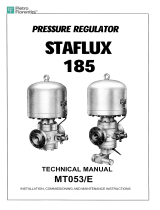 PIETRO FIORENTINI Staflux 185 Owner's manual
PIETRO FIORENTINI Staflux 185 Owner's manual
-
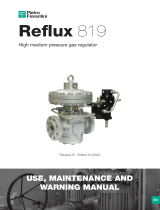 PIETRO FIORENTINI REFLUX 819 Owner's manual
PIETRO FIORENTINI REFLUX 819 Owner's manual
-
 PIETRO FIORENTINI Staflux Mini Owner's manual
PIETRO FIORENTINI Staflux Mini Owner's manual
-
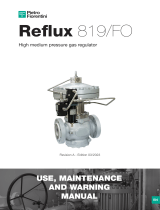 PIETRO FIORENTINI Reflux 819/FO Owner's manual
PIETRO FIORENTINI Reflux 819/FO Owner's manual
-
 PIETRO FIORENTINI Cirval Operating instructions
PIETRO FIORENTINI Cirval Operating instructions
-
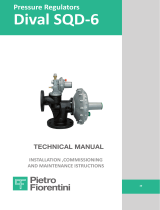 PIETRO FIORENTINI Dival SQD-6 Owner's manual
PIETRO FIORENTINI Dival SQD-6 Owner's manual
-
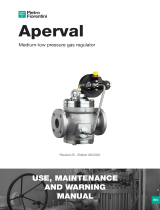 PIETRO FIORENTINI Aperval Owner's manual
PIETRO FIORENTINI Aperval Owner's manual
-
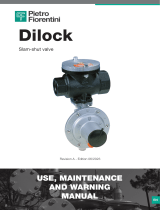 PIETRO FIORENTINI Dilock Owner's manual
PIETRO FIORENTINI Dilock Owner's manual
-
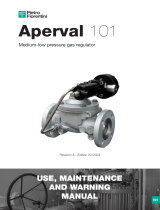 PIETRO FIORENTINI Aperval 101 Owner's manual
PIETRO FIORENTINI Aperval 101 Owner's manual
Other documents
-
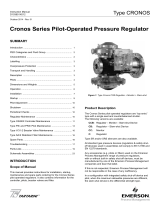 Tartarini Cronos Pressure Regulators Owner's manual
Tartarini Cronos Pressure Regulators Owner's manual
-
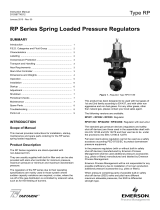 Tartarini RP Series Owner's manual
Tartarini RP Series Owner's manual
-
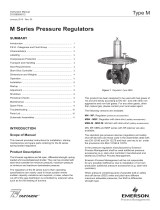 Tartarini M Series Pressure Regulators Owner's manual
Tartarini M Series Pressure Regulators Owner's manual
-
Emerson TARTARINI User manual
-
Emerson CSB400 User manual
-
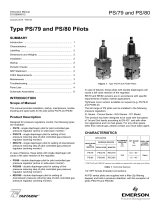 Tartarini PS/79 and PS/80 Pilots Owner's manual
Tartarini PS/79 and PS/80 Pilots Owner's manual
-
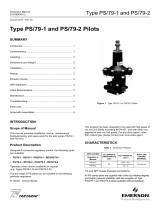 Tartarini PS/79-1, PS/79-2 Pilots Owner's manual
Tartarini PS/79-1, PS/79-2 Pilots Owner's manual
-
Tartarini A100 Pressure Regulators-Safe User guide
-
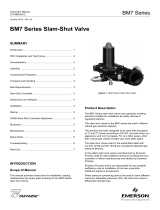 Tartarini BM7 Series Slam-Shut Valves Owner's manual
Tartarini BM7 Series Slam-Shut Valves Owner's manual
-
Fisher EZH OS2 User manual




















































